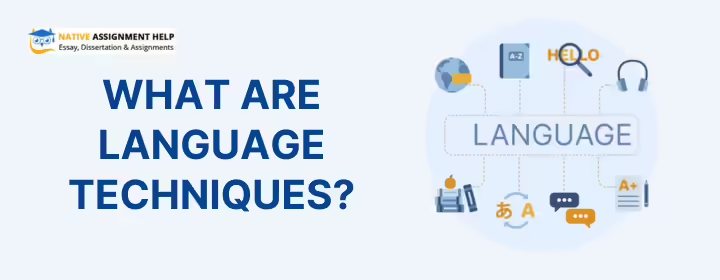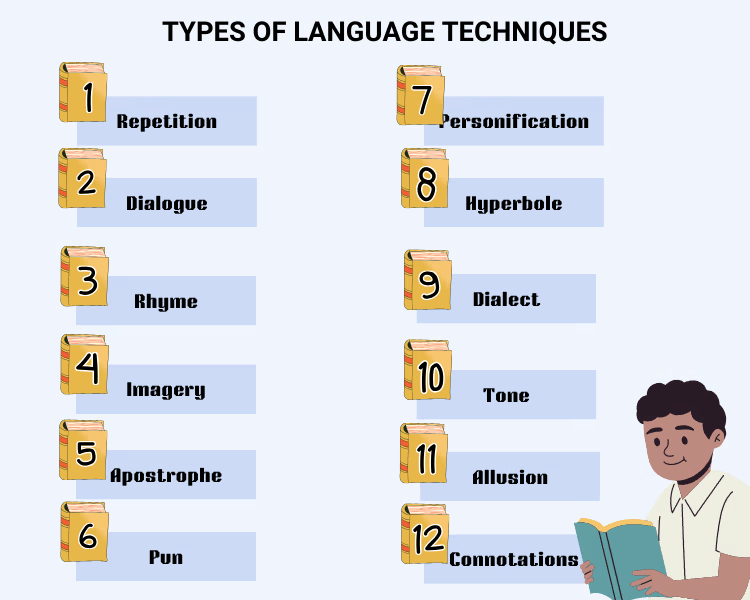
What are language techniques?
Language techniques are the components added to content to communicate your thoughts effectively. They are like magic ingredients that make your writing awesome! Using these techniques, you can turn boring sentences into super interesting ones by playing with how you structure your sentences, the tone you use, and the words you choose. These techniques come in different types, depending on your goal. For example, when you want to compare two things, you can use the "simile" technique, which involves using "like" and "as." This helps your readers see similarities between different things.
Have you ever thought about how this works? This article is all about helping you understand language techniques and examples, how to use them, and how to analyse them in your writing.

30+ Most Common English Language Techniques and Their Effects, Uses in 2025
Let’s examine various English language techniques, along with suitable examples, to understand how to apply them effectively in your text.
Metaphor and Simile
The similarity between these two techniques is they both compare two components. But there are some differences. While simile implies using words “ like” and “ as” metaphor doesn't. A metaphor is a direct comparison suggesting that one thing should replace another.
For eg: If we write He is like a paradox, it is a simile
But if we eliminate “ like” and write He is a paradox, it is a metaphor
One more apparent difference is that metaphor is the broader term of the two and can be used for longer text. Simile’s use is limited to sentences only. Altogether, both aim to create a picturisation of an object with something else that is easy to visualise.
Alliteration and Assonance
These literary devices imply using similar-sounding words to develop rhythm, mood and interest in readers. We call it alliteration when we use the repetition of vowels in words. Similarly, its assonance is when the first consonant syllable or the stressed syllable is repeated throughout the sentence.
For eg: In the lines from The Brook “And Many a Fairy Foreland set With willow weed and mallow”
You can find both alliteration and assonance. The words Fairy and Foreland have the same syllable “ f”, so it's assonance. The words willow and mallow have similar vowel sounds “o”, denoting it to be alliteration.
Hyperbole
When we add exaggeration in a sentence that isn’t supposed to be taken on a seriously note but is used to add emphasis, it is called hyperbole. The readers are supposed to understand the need for exaggeration rather than find it misleading. Hyperbole defines the magnitude of the object being exaggerated.
For eg: It took me forever to find a parking spot.
The word “ forever” is an exaggerated term here as it’s obvious that it can't take as long as forever for such a little task. Yet the term is used here, denoting how time-consuming it was to find the parking spot.
Personification
This English language technique gives a human or living-like character and behaviour pattern to inanimate or non-living things. The goal is to present abstract ideas in a relatable way.
For eg: The city never sleeps, always buzzing with energy.
Here, a city being a non-living object is said to be ‘not sleeping’ which is a human behaviour. But the message delivered here is the people who live in the particular city are awake or busy even at bedtime. The sentence is framed in this way because it is more appealing to read understand and connect to what is being said.
Irony and Sarcasm
Irony illustrates the contradiction between what is expected or is fact and what is being said or done. It can be of different types including situational, verbal or dramatic. Sarcasm is a type of irony that means saying the opposite of what’s expected. Sarcasm is used to convey mockery or criticism.
For eg: Saying "Oh, great!" when something bad happens.
In the above sentence, the expected response to a bad circumstance would be “ Oh, no or a tragedy. Giving an opposing response adds deeper meaning, humour and contradiction, keeping the readers engaged. Situation irony example can be “ A professional swimmer drowns in a bathtub”.
Rhetorical Questions
A rhetorical question doesn't demand an answer but is framed in question format to make an evident point. It is an indirect way of conveying a message that readers are expected to contemplate by themselves. This technique is useful in speech or persuasive writing.
For eg: “ Is this the time to come to school”?
In the above sentence, the question doesn't directly state that the other person is late for school. But it is provoking the listener or reader to comprehend this message which they must be aware of.
Imagery
Using terms to create imagination for objects, feelings, situations etc is known as imagery.
For eg: The golden sunset bathed the horizon in a warm, amber glow.
See how in this example words like golden, warm and amber glow help in imagining the appearance of the sunset.
Symbolism
It's called symbolism when we use certain words or objects as symbols to denote and represent ideas, concepts, and emotions.
For eg: The ring in “ Lord of the Rings “
Here the ring symbolises corruption and power possessed by its owners. In a sentence, symbolism may appear as “ One ring to rule them all, one ring to find them, one ring to bring them all and in the darkness bind them.
Idiom and Cliché
A cliche is used for those phrases or idioms that used to sound innovative once but are not anymore. Due to its overuse everywhere, it might be less interesting or unique to read or hear in content.
For eg, Only time will tell!
This phrase suggests the notion of waiting for an outcome. It is repeatedly used in media and creative writing.
Allusion
When you use famous or well-known places, people events, movies, and book names in your text to enhance relevancy, it is called allusion. It helps in the right delivery of context.
For eg: She’s the Einstein of our class
Everyone knows Einstein and his high intellect. Therefore it became easy to understand that the writer wants to convey that “ she” is intelligent.
Satire
This literary device brilliantly uses humour, irony, and exaggeration to focus on the issues that concern it. This is done to expose the foolishness, and vice of individuals or groups. It aims to inspire or evoke change.
Eg: Diet soda cancels out a double cheeseburger right?
In the above sentence, the cultural hypocrisy of sticking to trending diet food yet not following a balanced diet is focused upon.
Pun
A pun is used as a wordplay in which one word can have two different meanings. Words which sound the same but have different meanings can also be cleverly used.
Eg: Time flies like an arrow, and fruit flies like a banana.
Here, “flies” is used as a verb, and the second half is used for the insect “flies.” When both are used in the same sentence, it creates a humorous effect.
Dialect
A dialect is the form of language used for a specific region, or people with different cultural backgrounds. It is used in creative writing to portray the authenticity of a character’s description.
For eg “I ain't got no money for that," she said,in her Southern dialect thickening the words.”
Through this example, it is possible to believe that the fictional or non-fictional character.
Epiphany
In general terms, epiphany refers to a moment when a character gets a sudden realisation that changes their understanding. This literary device is used to portray plot change and character development.
Eg: After years of struggling in his career, John suddenly realized that his true passion was teaching, not climbing the corporate ladder.
In the above example, there is a sudden realisation of self-capabilities.
Caricature
A caricature language technique is used to portray features of characters in an exaggerated manner. This is done to emphasise traits related to their personality description.
For eg: The class topper wears glasses as thick as a magnifying glass with droopy eyes.
This description symbolises the character’s immersion in studies.
Anachronism
It is called anachronism when objects or the course of events are mentioned in a period where they don't exist. This is done deliberately to create amusement.
Eg In a medieval movie, a knight pulls out a wristwatch to check the time.
In the above example, a wristwatch is an anachronism as watches didn't exist in the medieval period.
Vignette
A vignette deeply describes an event or scene that draws attention toward a particular moment and readers can also experience it.
By the fire’s soft glow, the old man’s trembling hands held a faded photograph of his late wife. Her smile, captured in time, brought warmth that the fire couldn’t match. In that silent moment, the weight of his loss and memories hung heavily in the air.
Eg: This vignette creates a shot of loss and remembering someone dead.
Flashback
When the narrative shifts towards past incidents, it's called a flashback. It is used to give additional context related to something happening in the present.
Eg: Watching children in the park, she was reminded of her childhood days with her mother.
In these two time periods, one of the characters is an adult and another where she is in her childhood are narrated.
Onomatopoeia
Onomatopoeia is used for words that imitate the sound associated with objects, or animals. It is done so that reader can imagine and relate to what they experience in daily life.
Eg: "The leaves rustled in the wind, whispering secrets of the forest."
The word rustled mentioned along with leaves demonstrates the specific sound of leaves moving.
Advanced English language techniques
There are certain language techniques that not all writers use but are as important and effective as the common ones. Let’s learn about a few in the following text:
Anaphora
Through anaphora, you repeat a set of words or phrases in your content to emphasise those words and sentences coming after. The writers use them to create a rhythm, link compare or give contrasting ideas. This draws attention towards an important part of any content.
For eg: “We shall fight on the beaches, we shall fight on the landing grounds, we shall fight in the fields and the streets, we shall fight in the hills." (Winston Churchill)
Here we shall fight is being repeated, as the writer wants to convey a motivational tone to the speaker about willingness to fight in different settings.
Euphemism
This technique is used to present harsh or ugly truths, but actual words are replaced by words that sound less oppressive than reality. This puts readers at ease and softens the unwanted situation that is difficult to speak about.
For eg: My grandfather passed away this morning.
In the above sentence passed away is used instead of died as it is not a very pleasant word to hear or say.
Paradox and Oxymoron
When two opposite and contradictory thoughts or statements are put together, it becomes a paradox. It subtly brings out some humour or a hidden truth about the theme of the writing.
For example: in Shakespeare’s Hamlet, he writes “ I must be cruel, only to be kind”
In this sentence he wishes to depict that to show kindness to the person, he has to be cruel to him for his greater good. When two opposing terms are used in the same sentence it's called an oxymoron. For eg “ bittersweet” is used to describe an experience that was pleasant and painful simultaneously.
Practical Applications of Language Techniques
If you are a student and learning and practising language techniques GCSE, you must wonder if it will come in handy in future. Well the answer is yes, we use this language technique in our everyday life as well as while pursuing something related to writing or speaking. More details are mentioned below:
- In Literature: In literature, the writers aim to convey their ideas, thoughts, moods, and style through language techniques. For eg, imagery affects readers' five senses by describing smell, taste, sound, and a touch of something readers have experienced.
- In Advertising and Marketing: Writers and speakers ought to convince the audience to buy their products or services. Using language techniques like rhetorical questions, and emotive language draws attention and encourages readers to get involved.
- Education and teaching: Language techniques are also useful in understanding and explaining concepts. For eg simplification and analogies can be used to compare two objects and understand them in a better way.
Why Understanding Language Techniques is So Important?
If you're a student studying for language technique GCSE, or you love getting creative with your writing, it's important to learn these thoroughly. Understanding these techniques will boost your skills, including:
- Make your writing clearer and more cohesive, so your message gets across better.
- Getting better at figuring out the deeper meaning in texts, is awesome for critical thinking.
- Using certain techniques to be more persuasive, can help with public speaking and presentations.
- When working on essays, speeches, stories, ads, or any creative content, it's super important to develop a sentence that captures what you want to say.
- Becoming a better writer who can express thoughts clearly to readers.
Steps to Analyse Language Techniques in a Text With Examples
"The wind whispered through the trees, gently brushing the leaves as if sharing a secret only nature could understand."
- STEP1: Read the text carefully: Analyse the complete text to comprehend the overall tone and meaning. For eg: The information about wind creates a calm and gentle scene in our mind as we read it.
- STEP 2: Identify key language techniques: Look for identifiable features by examining figurative language, sound devices or imagery.
Language Techniques Examples: In the text, personification is there as the word “ Wind Whispers” suggests the human-like behaviour of wind. Additionally, the line gently brushing the leaves gives a sense of a soft, delicate moment.
- STEP 3: Comprehend the Effect of Technique: Evaluate the overall mood, tone and theme that is created by the use of language technique.
Language Techniques Examples: The use of personification imposes a serene and peaceful environment, making trees appear alive. The use of imagery uplifts the reader’s sensory experience and creates a vivid image of “ leaves brushing.
- STEP 4: Connect with the author’s objective: After analysis, it can thought that the author is using personification and imagery to emphasise on beauty and calmness of nature. Looking at deeper meaning, it suggests that nature has its language that we cannot quite understand.
- STEP 5: Estimate the overall effect on the reader: Understand the reader's perception of the text. What kind of emotion or thought the text is making the reader feel?
Language Techniques Examples: This kind of text makes the reader experience a connection to nature and appreciation of its beauty.
- Step 6: Pen down your thoughts and analysis: After having understood what language techniques are present in the text, you need to break down the intent behind using them. Understanding the core objective or hidden message behind texts is part of language technique analyses
These tips will be very helpful in understanding the application of various language techniques in a text.
Can you identify 5 different language techniques used in the following text?
“The old oak tree, standing tall and proud, whispered secrets to the wind, its leaves dancing in the soft breeze. Beneath its sprawling branches, time seemed to slow, wrapping the world in a gentle embrace. The sun, a golden orb in the sky, cast warm rays that kissed the earth, painting the scene in hues of amber and gold. This ancient sentinel, rooted deep in history, held stories in its bark, each ring a testament to years gone by. "Is there anything more timeless?" one might wonder, feeling the peaceful weight of nature's wisdom in the air.”
In conclusion, language techniques are an important part of writing and communicating different points and emotions. The actual number of language techniques is unlimited but we discussed some major important of them in this article. Language techniques are not only a part of the curriculum in GCSE but are very useful in daily life or pursue careers related to writing or speaking. So you need to understand how these are used, so it becomes easy for you to utilise them in writing something very creative.
Reference - Discover the power of Types of language techniques to enhance your writing and communication skills.
Learn language techniques via Best English Experts at Native Assignment Help
Learning about language techniques is far from easy, and professors don’t explain each one of them with the utmost attention. You should learn from our English assignment to help experts from the comfort of your home. You can privately chat with them and get all your queries cleared by them. Native Assignment Help has a team of PhD holders in English so you have multiple options for choosing your suitable tutor. Have doubts or projects you want guidance in? Contact our assignment help services and get the best results within a few days.



